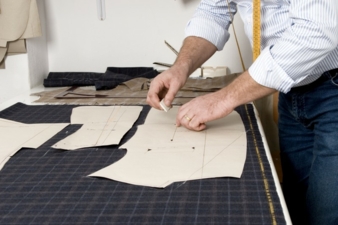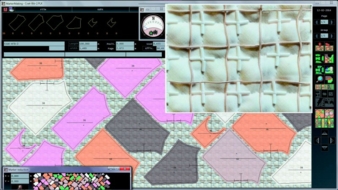08/07/2015 — auf Deutsch lesen
Lectra: Maggy London is “perfectly placed”
International fashion company Maggy London, which has headquarters in New York, New Jersey and Hong Kong, produces nine collections in five seasons each year. Since 1973, Maggy London has catered to both private labels as well as retail clients from the fashion industry, distributing brands such as Maggy London, Donna Morgan and London Times Fashion. The clients place particular value on high quality, and demand low prices and a constant influx of new products. The company must therefore keep costs under control and times to market short.
Alex Canoro explained how, earlier, the prints from the designers would be shuffled around the table in pieces in order to get the pattern positioned correctly. His task was to arrange the markers as efficiently as possible by hand. “It could take five to six metres of fabric to cut out a garment in the look desired by the designer. So I had to rearrange the print placement to reduce material usage to less than two metres.” Despite his many years of experience as head of the marker department, Canoro had constant doubts about this largely manual process: “There was always a point where I could no longer be sure whether my manual marker arrangement on the table was really feasible.”
Before, the markers had to be adapted to the final print. Today, using the Diamino software solution for pre-costing and marker creation from Lectra, Canoro combines print designs directly with markers on the screen. Real material samples are scanned in or imported via Lectra’s Kaledo design software, Canoro then places the marker layout onto the background of the material. He works in collaboration with the designer from the very beginning, in contrast to before, when he would forward the print, procure the material and only then request the designer to come up with a draft design.
He uses the fabric lengths and widths optimally, which ultimately results in perfectly placed markers within a shorter amount of time. Should the pattern not be suitable for the print design, he is able to give his feedback to the print department from the outset. “The best thing is that now I work together with the designer right from the beginning,” said Canoro. Non-specialists such as product managers, and the heads of the tailoring department, research department and product development team are all able to access this information at the same time.
Fabrics can be visualised in the marker layout in order to monitor costs even during the material selection phase. At the same time, clear visual instructions are provided for repeated marker placement and orientation. Canoro provides more accurate information for product development, which ensures that production is more precise. “The product department can depict the mini-marker provided with the fabric length, and, together with the contractor, work out the optimal arrangement of the markers. Design placement no longer involves large amounts of guesswork,” explained Canoro.
British label Maggy London is known for its brightly-coloured dresses with elaborate designs. Alex Canoro, head of the marker department, accurately positions the markers for a sheath dress onto the colourful fabric sample. Using modern software, what had previously been guesswork has today been rendered child’s play.
Maggy London is known for its dresses, many of which feature engineered prints. The company produces 5 seasons of 9 lines every year, both for private label and in-house brands. With all this activity and a desire to grow, Maggy London ran up against the limits of manual marker placement. It was slow and tedious and did not provide the level of precision the company needed to accurately estimate material consumption and stay within margins.
Maggy London and Lectra have been partners for over 20 years. When finding a more efficient way to engineer prints became a necessity, the two companies pooled their knowledge to develop a solution that worked. “We laid out the platform and Lectra built it and sent it to us. We beta tested it and it just continued to unfold. It’s been very successful,” says Lisa West, Vice President of Operations. Today, Maggy London is able to import fabrics into Lectra markers to quickly visualize marker layouts and estimate material use with consistent accuracy.





